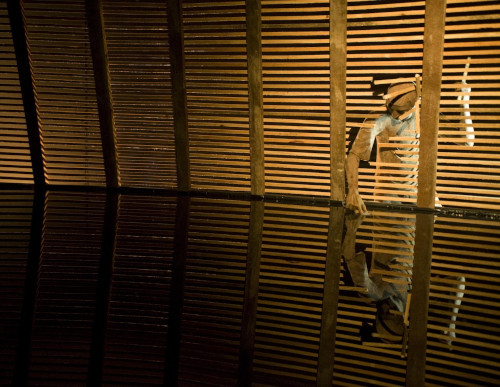
After all the radio signals emitted from space may not be extraterrestrial, in a paper publish in the Physical Review Letters, from João Rosa's work from the Department of Physics of the University of Aveiro.
They are known among the astronomers by Rapid Radio Impulses (RRI) originating in the largest light explosions of deep space and detected on Earth in the form of very short radio signals, the nature of the impulses has been said a little bit, since they are emitted by alien beings until they are generated by neutron stars. But the mystery may be undone. João Rosa, a physicist at the University of Aveiro (UA), points out that, after all, the signals can be generated by the dark matter itself in the form of axions and black holes as old as the Universe itself.
Published this month in the prestigious Physical Review Letters with honors of "Editors' Suggestion," a distinction attributed to about one in six articles published in this journal, the work of the investigator of the Department of Physics and the Center for Research and Development in Mathematics and Applications from the UA point out a possible new solution to a mystery that has lasted since 2007, the year the first of those radio signals was detected. That year, more than thirty explosions followed by so many radio signals, many of them emitted more than a billion years ago in galaxies several hundred million light-years from Earth, were recorded.
"About thirty of such explosions, these RRI are known in the international scientific community as Fast Radio Bursts (FRB)] have been observed by telescopes in the last decade and, despite the many theories proposed to explain them, their origin remained unknown ", describes João Rosa whose work has now been published in collaboration with American researcher Thomas Kephart of Vanderbilt University.
Explosion of thousand million suns
The explanation for the phenomenon of the FRB came about by chance. João Rosa tried to show that, contrary to the postulate until today by the international scientific community, the instability of the black holes in rotation leads to the emission of electromagnetic radiation. Moreover, this instability, which gives rise to a cloud of axions in a curious donut shape around the black hole, not only emits radiation but this is the largest of which there is record in the Universe. "It's an explosion of electromagnetic radiation equivalent to a thousand million suns," says João Rosa.
In fact, according to João Rosa, "the combination of two of the most popular candidates to explain the mysterious dark matter that permeates the Universe, axons and primordial black holes can generate some of the brightest explosions in the Universe."
The primordial black holes were originally postulated by Hawking in 1971 and formed shortly after the Big Bang following the gravitational collapse of regions of extremely high density.
"These black holes may be much smaller and lighter than known black holes with mass above the Sun. If these black holes are produced in a large enough number in the primordial Universe, they may also explain a significant fraction of the dark matter, probably not explaining it in its entirety, "he describes.
When two of these black holes meet, the Physics Department investigator points out, "they form a binary system and eventually collide and form a new, heavier black hole and typically rotate quickly over itself." If axions exist and are light enough, they can cause this new rotating black hole to become unstable. "This super radiant instability, as it is known, forces the black hole to reduce its speed of rotation by producing axons in its vicinity, in the form of a dense cloud of axons around the black hole, approximately in the shape of a 'donut', "he says.
Doors open to study dark matter
"Although this instability had been predicted theoretically for over four decades, until now no one had considered the fact that the axons themselves are unstable particles, and may decay into pairs of photons, some elemental constituents of light. Although the probability of this decay occurring spontaneously is small, such that an axion has an average life above the age of the Universe, the decay of an axon can be stimulated by the passage of a photon, "the investigator describes.
Each of the photons resulting from this decay can thus find a new axion as it travels within the cloud of axons and stimulate its decay, producing two new photons that may in turn stimulate the decay of more axions, and so on. This 'domino effect', he compares, 'is very similar to what happens in a typical laser, leading to the production of a very large number of photons.'
João Rosa showed in this work that the clouds of axions formed around small primordial black holes may be so dense that a small number of photons will suffice to stimulate the decay of a very large number of axons, producing an extremely powerful and luminous laser.
"We called this new phenomenon a" BLAST "because of its explosive nature, since a cloud of axons can reach great luminosity in a very short time, at the end of which fails to withstand the very strong electromagnetic field generated by the laser in its interior and the laser 'off'.
"Our analysis has also revealed something quite surprising that BLASTs may have already been observed. For axions to naturally explain most of the dark matter in the Universe, its mass should be about fifty billion times less than that of the electron. In this case, we predicted that the BLASTs will correspond to electromagnetic explosions in the radio range, with frequencies of the order of GHz and duration of only a few milliseconds, shining in this short period as about one billion suns, "says the paper.
About thirty such explosions known as FRB have been observed by telescopes in the last decade, and despite the many theories proposed to explain them, their origin remains unknown.
"Our results thus suggest that these powerful celestial explosions may originate in dark matter itself, in the form of axions and primordial black holes," says João Rosa. This could thus "constitute a new astrophysical laboratory to test the nature of dark matter, its role in elementary particle physics, and also the extreme conditions in the Universe shortly after the Big Bang."









